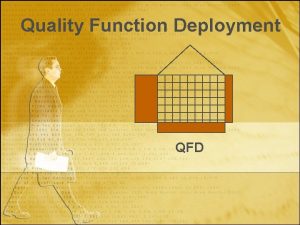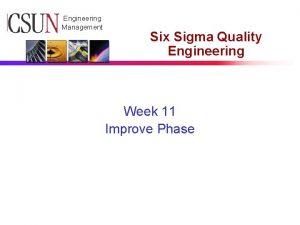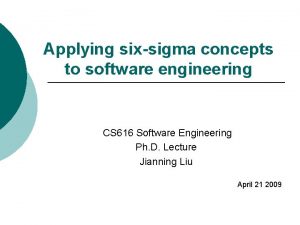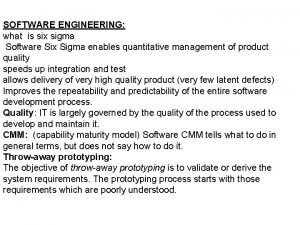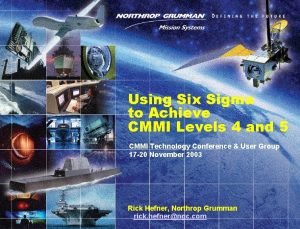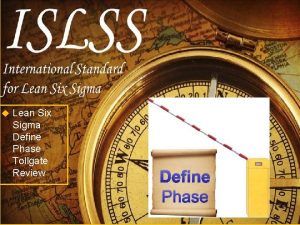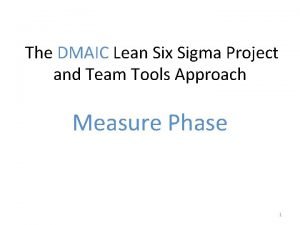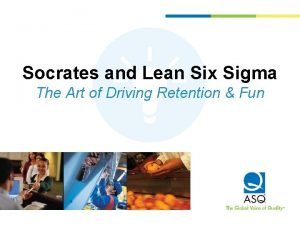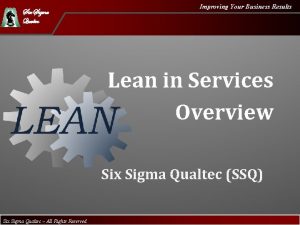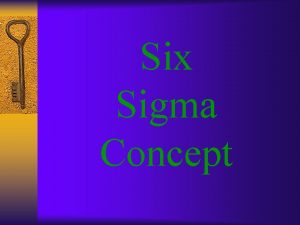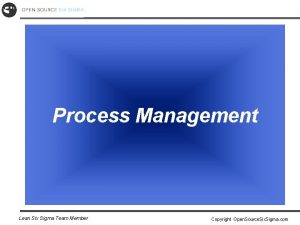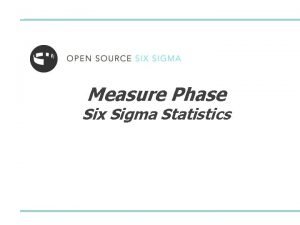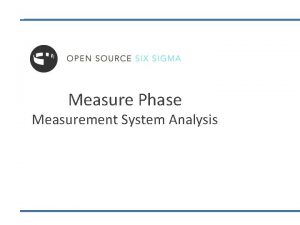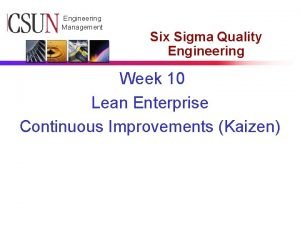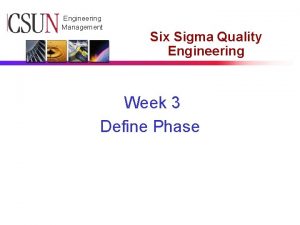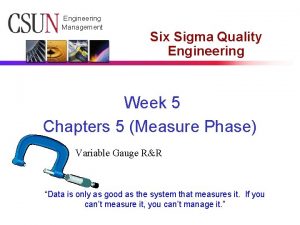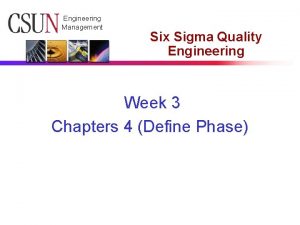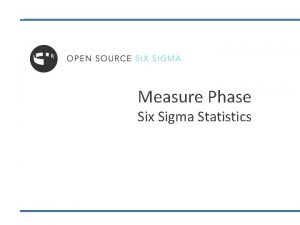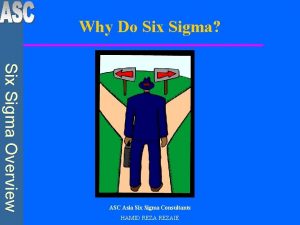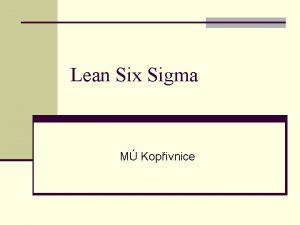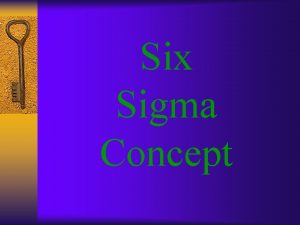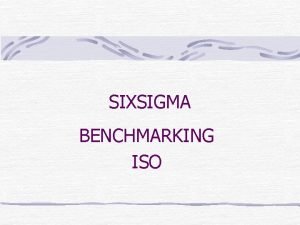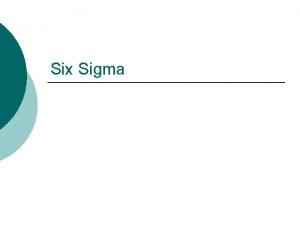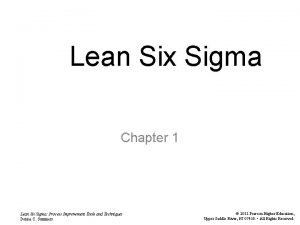CSUN Engineering Management Six Sigma Quality Engineering Week





















- Slides: 21

CSUN Engineering Management Six Sigma Quality Engineering Week 11 Improve Phase

Objectives l Overview of Design of Experiments • A structured method to learn about a process by changing many factors at the same time. • It occurs in Improvement Phase. • Fractional factorial experiments are used for initial screening • Full factorial experiments are smaller and more precise l Graphical Analysis • Main effects plots • Interaction plots • Cube plots l Statistical Analysis • P value for main effects and interactions

Six Sigma - DMAIC Roadmap

Improve Phase Improve Develop, try out & implement solutions that address root causes l l l Key Deliverables Solutions Risk Assessment on Solution Pilot Results Implementation Plans Goal: l Develop, try out, and implement solutions that address root causes Establish Optimum Process Select Solutions g Improvement g FMEA for Strategies Solution g Screen Critical g Cost Benefit Inputs (DOE Plan) Analysis g Refine Model g Verify Metrics g. Define & Confirm (x) Y=f g Prioritization Prepare improvement Plans g Document ‘To Be’ Process g Pilot Solution g Implementation & Deployment Plans g Process Documentation Matrix Output: l Planned, tested actions that eliminate or reduce the impact of the identified root causes

Improve Phase Cost-Benefit Analysis Perform cost-benefit analysis for the preferred solution Generating Solutions A B C D Design of Experiments 4 1 3 2 Generate solutions including Benchmarking and select best approach based on screening criteria Use DOE and response surface optimization to quantify relationships. Selecting the Solution Implementation Piloting Assessing Risks Original Test Full scale 1 2 3 4 5 C Pilot the solution on a small scale and evaluate the results 8 9 10 D F H Use FMEA to identify risks associated with the solution and take preventive actions 7 B G E Recommend a solution involving key stakeholders. 6 A G I J Develop & Execute a full plan for implementation and change management

CSUN Engineering Management Design of Experiments

What is a Designed Experiment? A method to change all the factors at once in a structured pattern to determine their effects on the output(s) l The structured pattern is known as an orthogonal array l A B AXB 1 -1 -1 1 2 1 -1 -1 3 -1 1 -1 4 1 1 1 0 0 0

Full Factorial Designs l Full Factorial: Examines factor effects and interaction effects. These become large rather quickly. • • l 22 Full Factorial = 2 factors, 2 levels = 4 runs 23 Full Factorial = 3 factors, 2 levels = 8 runs 24 Full Factorial = 4 factors, 2 levels = 16 runs 25 Full Factorial = 5 factors, 2 levels = 32 runs Used after initial screening experiments or where the process is simple or well known. The experiment is run to optimize the process using a vital few factors.

Example of a 23 Full Factorial Design Run

Fractional Factorial Designs l Fractional Factorial: Examines factor effects and a carefully selected portion of interaction effects. l Shrinks the number of runs for each fraction by one half. • • • 27 Full Factorial = 7 factors, 2 levels = 128 runs 2(7 -1) 1/2 Fractional Factorial = 7 factors, 2 levels = 64 runs 2(7 -2) 1/4 Fractional Factorial = 7 factors, 2 levels = 32 runs 2(7 -3) 1/8 Fractional Factorial = 7 factors, 2 levels = 16 runs 2(7 -4) 1/16 Fractional Factorial = 7 factors, 2 levels = 8 runs

Fractional Factorial Designs Uses interaction column settings to estimate the effects of main factors. l Used for initial screening designs to isolate the important (vital few) factors. l One Do. E leads to another. Fractional Factorial Do. E’s lead to smaller Full Factorial Do. E’s. l

Basic Experimental Terms

The Idea of Confounding 2 (a) A B 1 -1 C AB -1 -1 AC -1 BC 1 ABC 1 -1 -1 1 3 (b) -1 1 5 (c) -1 -1 1 1 -1 -1 1 8 (abc) 1 1 1 1 Same Signs Was “Y” affected by A or by the interaction of B and C?

Basic Experimental Terms

Basic Experimental Terms

Basic Experimental Terms

General Comments l l l In general, industry considers 3 rd and 4 th order interactions to be negligible. Fractional Factorial experiments “pool” the effects of interactions to estimate residual error. No replicates are run - USE WITH CAUTION! Use Fractional Factorial Experiments for screening, then follow up with Full Factorial Designs. Keep your experiments simple

Be Proactive! DOE is a proactive tool. l If Do. E output is inconclusive: l • You may be working with the wrong variables • Your measurement system may not be capable • The range between high and low levels may be insufficient l There is no such thing as a failed experiment • Something is always learned • New data prompts asking new questions and generates follow-on studies

CSUN Engineering Management Design of Experiments Minitab practice

Design Resolution The resolution number tells you what factor and interactions will be confounded with one another.

Questions? Comments?
 Qfd in six sigma
Qfd in six sigma Csun engineering management
Csun engineering management Engineering management csun
Engineering management csun Csun engineering management
Csun engineering management Six sigma strategy in software engineering
Six sigma strategy in software engineering 6 sigma software
6 sigma software Sigma sigma phi vcom
Sigma sigma phi vcom Vcom auburn white coat ceremony
Vcom auburn white coat ceremony Week by week plans for documenting children's development
Week by week plans for documenting children's development Cmmi six sigma
Cmmi six sigma Microsoft six sigma
Microsoft six sigma Describe what we do at a tollgate meeting?
Describe what we do at a tollgate meeting? Statapult exercise
Statapult exercise A socratic approach to lean six sigma
A socratic approach to lean six sigma Six sigma qualtec
Six sigma qualtec Lean six sigma forum
Lean six sigma forum Six sigma 99
Six sigma 99 Mse six sigma
Mse six sigma Lean storyboard
Lean storyboard Six sigma belts hierarchy
Six sigma belts hierarchy Statistical notation
Statistical notation Attribute msa kappa value
Attribute msa kappa value
